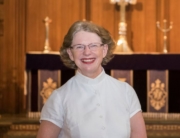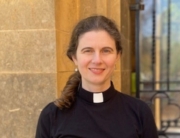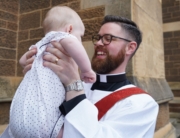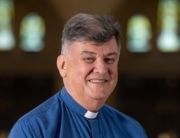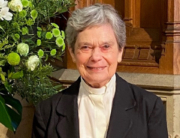Preacher: The Rev’d Dr Lynn Arnold AO
May the words of my mouth and the meditations of our hearts be worthy in your sight, O Lord, our Rock and our Redeemer. Amen
Today in our gospel reading we have been told once again about the miracle of the Transfiguration – one of six seminal events in the life of Jesus – along with his Birth, Baptism, Crucifixion, Resurrection and Ascension. The account of the Transfiguration appears in the three canonical gospels and is alluded to in John’s gospel (1:14). The event itself has been recorded in art through the centuries – understandably so, since it is such an important incident in the life of Jesus and the experience of those disciples who were with him.
To fully understand it, however, we need to consider the events that happened in the days prior to this miracle; in particular, Jesus foretelling his death and resurrection and, prior to that, Jesus asking Peter “Who am I?”
Every time I read of Jesus asking this question of Peter, I am reminded of a joke told by a British Anglican clergyman who spoke at a day meeting of clergy and laity here in this diocese about eight years ago. Some of you may have been there and heard it.
The joke involves a logistical crisis that has occurred in Heaven; suddenly an inordinate number of people are presenting themselves at the pearly gates requesting admission and the angels are overwhelmed, not knowing who to process quickly and who will need longer processing time. In despair, they appeal to Jesus to help them. So he comes to the gates and determines an easy question to ask each comer that will determine whether they are to be quickly admitted or whether they are to be sent to a waiting room for further processing.
So the first in queue, a Catholic, comes to him, Jesus asks him: “Who do you say I am?” The Catholic answers “Well Vatican II said …” but Jesus interrupts him before he can finish saying “I asked who you think I am. Go and wait in the waiting room.” The next to come is a Uniting Church member of whom Jesus asks the same question, receiving the answer: “At our last conference …” Again Jesus interrupts: “I asked who you think I am. Go and wait in the waiting room, we’ll come back to you later.” The next is a Baptist who answers Jesus’ question with “Well the Bible says …” – but again, before he can finish Jesus interrupts saying: “I didn’t ask what the Bible says, I know what it says, remember my Father and I ghost wrote most of it. I asked who you say I am. Go on, wait over there.”
The next in the queue is an Anglican. The all-knowing Son of God knows this of course, but he doesn’t know what answer is about to be given; however, he is not particularly optimistic as he is aware of a reputation for ambivalence on the part of Anglicans. Still Jesus persists and asks the question: “Well, who do you say I am?”. The Anglican responds: “You are the Messiah, the Chosen One, the Son of God, the Incarnate One.” Though it is well nigh impossible to imagine, Jesus is flabbergasted – he had not expected this answer. Unbelievable as this may sound, he was momentarily speechless; but as he starts to recover himself and is about to say “Come on in, the gates are open for you”, the Anglican continues speaking, saying: “On the other hand …”
When asked this self same question, Peter had been in no doubt. He answered firmly and succinctly “You are the Messiah” [Mark 8:29]
Do we answer the question with such firmness and succinctness? Therefore, it is into this space of uncertainty about the ‘who-ness’ of Jesus that Transfiguration should speak to us all in our time as much as in Peter’s.
As we come to reflect on the account of the Transfiguration this morning, we should each do so in the context of that very same question and reflect upon how we honestly answer it. Who do you say Jesus is?
The answer to that question is the key element to understanding what took place on that day of the Transfiguration. Let us agree on the basic facts first. According to the gospels of Matthew and Mark, six days after Jesus foretold his death and resurrection, (eight days according to the gospel of Luke), Jesus went to an unnamed mountain and there encountered Moses and Elijah. They then disappear and, a short while later, God speaks.
The vagueness about the number of days according to the three gospels does not disturb me; on the contrary, I find that vagueness affirming as to the veracity of the story – for Matthew, Mark and Luke all relate the important points of the event with great similarity; the unimportant point, that of how many days after Jesus’ foretelling of his death and resurrection it took place, six or eight, really is just that -unimportant. Likewise, the anonymity of the mountain is also of no consequence. Over the centuries, some have said it took place on Mt Tabor, others have said it was Mt Nebo, or Mt Hermon or Mt Panium. It not only doesn’t matter that we don’t know where all this took place, it is actually important that we don’t – for if we did know, many of us might be tempted to turn that piece of geography into a shrine. But it was never the ‘where’ that was important in the Transfiguration, it was the ‘who’ and the ‘what’.
Who were the ‘who’, apart from the three onlookers, John, James and Peter? The three main people that day were clearly Jesus, Moses and Elijah. Even though Peter has, only days before, acknowledged Jesus as the Messiah, the appearance of such luminaries as Moses and Elijah really impressed him. He had been travelling with Jesus for nearly three years by this stage, seen amazing things, called him the Messiah, yet never once did Peter suggest erecting a special tent for him. But when Moses and Elijah appear, Peter was hugely impressed – ‘look who Jesus knows!’ – and, by consequence, he became even more impressed with Jesus too – for he saw Jesus talking to these two very famous people.
The choice of Moses and Elijah as participants in the Transfiguration was significant. Moses, the chosen one who nevertheless died before he could enter the Promised Land; and Elijah, one of only two people in the Old Testament not to die. Here they meet Jesus who, by his own prophecy, would both die and not die – that is death would not defeat him. So what should the disciples have gleaned from the experience? What should we?
The appearance of Moses had significance on two counts. Firstly, this chosen one of God, who was denied the opportunity to enter the Promised Land, was not only no longer dead, he was now very much alive again and, what is more, talking to the Promised One. When Moses had been in conversation with God on Mount Sinai, he could not look at God; but now, notwithstanding the exceeding brilliance of the light that shone from Jesus, not only could Moses look at him, so could John, James and Peter.
Elijah’s presence, on the other hand, was a fulfillment of prophecy. In Malachi (4:5-6), Elijah’s return was foretold. Seeing Elijah with Jesus, the disciples understood that this fulfilment was occurring in their presence, but could not comprehend the reason; they asked, in verse 11:
Why do the scribes say that Elijah must come first?’
In asking the question, the disciples were aware that the prophecy in Malachi had been bleak; that it had spoken about:
… the coming of the great and dreadful day of the Lord.
But this day would not be such a ‘great and dreadful day’ but a testimony to God’s love for his people, proven through Jesus. For, in responding to the disciples’ questioning, Jesus made it clear that the ‘great and dreadful day’ would be suffered by he himself, not by humanity:
How then is it written about the Son of Man, that he is to go through many sufferings and be treated with contempt? [v12]
But there is another point of great significance to the events of the Transfiguration. There on the mountain top something qualitatively different happened from everything that the disciples had experienced in the relationship with Jesus to that point. To that point, Jesus had been that exceptional person, performer of miracles, wise beyond earthly measure but still a Messiah in the old Judaic concept.
As Rev Michael K Marsh, an American Episcopalian from Texas, has put it:
Most … seek God in the circumstances of life. This is the God who does.
But Marsh says that this is only the first part of our spiritual journey; there is a second part:
At some point we must … begin to discover the God who is beyond the circumstances. This is the God who is.
It is at the Transfiguration that the disciples would begin to understand that. Their perceived Jesus of the circumstance, the God who does, was revealed to be something different from the real Jesus. Marsh writes:
Jesus did not suddenly light up and become something he was not. No, their eyes were healed and opened so they could see Jesus as he had always been. The voice in the cloud was not new. Their ears were opened and they heard the voice that has never ceased speaking from the beginning. The transfiguration is as much about them as it is Jesus.
Jesus was no longer seen by the disciples to be the doer of miracles, he became the miracle. And at that moment, they too started a process of personal transfiguration that would reach fulfilment after the Resurrection.
When Peter had said to Jesus that he was the Messiah, he had been echoing prevailing thought about what that meant. In Jeremiah [33:15] we read about the character of the promised Messiah:
In those days and at that time I will make a righteous Branch sprout from David’s line; he will do what is just and right in the land.
But that would change; starting with the Transfiguration and finishing with the Resurrection, Peter would himself be transfigured from a follower into a believer – we know this, for in his second letter, Peter would write:
For we did not follow cleverly devised stories when we told you about the coming of our Lord Jesus Christ in power, but we were eyewitnesses of his majesty. 17 He received honor and glory from God the Father when the voice came to him from the Majestic Glory, saying, “This is my Son, whom I love; with him I am well pleased.”[a] 18 We ourselves heard this voice that came from heaven when we were with him on the sacred mountain. [2 Peter 1:16-18]
The Scottish poet Edwin Muir [1887-1959), in his poem “The Transfiguration”, wrote:
So from the ground we felt that virtue branch
Through all our veins till we were whole, our wrists
As fresh and pure as water from a well,
Our hands made new to handle holy things,
The source of all our seeing rinsed and cleansed
Till earth and light and water entering there
Gave back to us the clear unfallen world.
For this to be so for us, Jesus can no longer be the Messiah of the Judaic mould, but now has to be seen to be more than the law (represented by Moses), more than the prophets (represented by Elijah), he has to be seen to be the ‘very God of very God, begotten not made, being of one substance with the Father, by whom all things were made’ quoting from the Book of Common Prayer version of what we will say shortly in the Apostles’ Creed.
So, if Jesus were to ask you “Who do you say I am?” – What would be your answer?

